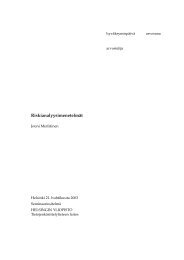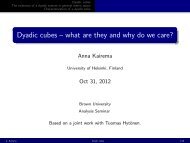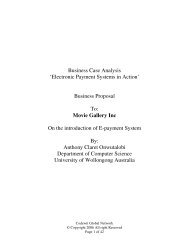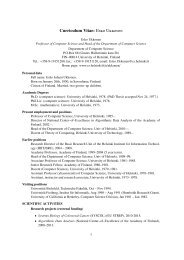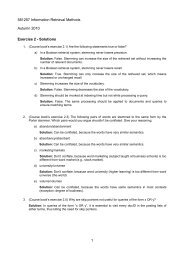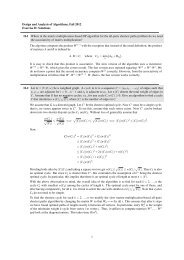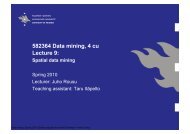Toni Sihvonen (order #92780) 62.142.248.1
Toni Sihvonen (order #92780) 62.142.248.1
Toni Sihvonen (order #92780) 62.142.248.1
Create successful ePaper yourself
Turn your PDF publications into a flip-book with our unique Google optimized e-Paper software.
<strong>Toni</strong> <strong>Sihvonen</strong> (<strong>order</strong> <strong>#92780</strong>) 6<br />
Scotney Castle (0-20): A Third-phase small castle surrounded<br />
on two sides by a lake. The owner is killed by<br />
rebellious Saxons in 531, and the castle falls to ruin soon<br />
after.<br />
Ruler: Sir Dinnan<br />
Vassal of: Earl Kynniarc<br />
Sheppey, Isle of (P-19): A low island lying at the<br />
mouth of the river Medway, mainly used to graze sheep<br />
(hence its name). The channel separating the island form<br />
the mainland is known as the Swale.<br />
Sonning (S. Sunning) (M-19): Until Badon this was the<br />
center of the Sunningas. an isolated theod. During the<br />
Badon campaign, the town was burnt by the Cymric<br />
forces of the north. It has since been rebuilt, and is inhabited<br />
by Cymric peasants.<br />
Southwerk (0-19): A suburb of London, it protects the<br />
southern end of London Bridge. It is famous as a pit of<br />
sin and debauchery.<br />
Stane Street: The Roman road from Chichester to<br />
London. It is one of the few routes through the Weald,<br />
heavily overgrown by trees and bushes.<br />
Steyning (5. Staenning) (N-20): Before Badon this was<br />
the center of the Staeningas theod. The town was given<br />
to Sir William de Braose, who dispersed the inhabitants<br />
and brought in Cymric peasants from his other lands. The<br />
village was recently cursed by St. Cuthman, who was<br />
jeered by the local farmers when the wagon carrying his<br />
invalid mother lost a wheel. Since then, it has always<br />
rained when the fields are due to be mowed.<br />
Thames River (M-18, M-19,0-19): Flowing from the<br />
heart of the Cotswold Hills, the Thames is navigable<br />
nearly its entire length. London was built at the first<br />
point where the Thames could be bridged. Saxons<br />
rowed the length of the Thames to raid and plunder far<br />
inland while London was under Saxon rule (503-507).<br />
Leaders returning from these raids were required to give<br />
a portion of their booty to the two Saxon kings who<br />
controlled London.<br />
Thanet (P-19): The Isle of Thanet is separated from the<br />
mainland by the Wantsum channel (9.v.). It is a lowlying<br />
island, good for farming. Vortigern gave it to<br />
Hengist in 446 - the first Saxon demesne in Britain.<br />
Tonbridge Castle (0-20): A post-Badon motte and<br />
bailey. Its lord defied Arthur and was captured and executed.<br />
Subsequently is was granted to Sir Cadwan, who<br />
upgraded it to ordinary castle status.<br />
Ruler: Sir Terren, then Sir Cadwen<br />
Vassal of: Earl Kynniarc<br />
Torberry Hill (M-20): A faerie hill whose inhabitants<br />
dance every Midsummer Eve at midnight. These rich fey<br />
have great treasures under the hill, say the locals.<br />
(Ambient 4d20, Summon Faerie Creature 3d20)<br />
Trottiscliff (0-19): A ley line passes through the temple<br />
to Wotan and a chambered tomb here. A tunnel, filled<br />
with treasure, is said to run between the two. The<br />
Down's Way (q.v.), which runs nearby, is haunted by a<br />
ghostly dog. (Ambient 2d20 [4d20 for Saxons]: Travel<br />
2d20)<br />
Wallbury (0-18): A hillfort dating from before the<br />
Roman invasion, resettled by the Trinovantes tribe when<br />
the Saxons began raiding. It held out for several years<br />
and served as a base for counter-raids against the Saxons.<br />
It fell in 495 when Oda and Eossa swept through the<br />
region on their way to St. Albans.<br />
Wantsum Channel (P-19): The channel separating the<br />
Isle of Thanet from Kent. It is fed by the Stour and the<br />
Wantsum. The channel has been silting up for centuries,<br />
and is now a low marsh with numerous watercourses<br />
cutting through it. The main channel is still navigable,<br />
and provides access to the Stour and thence to<br />
Canterbury.<br />
Watling Street (P-20, P-19, 0-19): The Roman road<br />
from Richborough to London. The road from Dover to<br />
Canterbury is usually included as part of Watling Street.<br />
West Malling Castle (0-19): This small castle is built<br />
late in phase Two by the Bishop of Rochester.<br />
Ruler: Bishop of Rochester<br />
Vassal of: King Arthur Pendragon<br />
West Wycombe (N-19): A church built within an<br />
ancient earthwork here is a meeting place for devil-worshipping<br />
magicians. They meet on the dark of the moon<br />
to plan their evil deeds. (Ambient 5d20, Curse 4d20,<br />
Necromancy 2d20, Summon Faerie Creature [evil]<br />
3d20)





